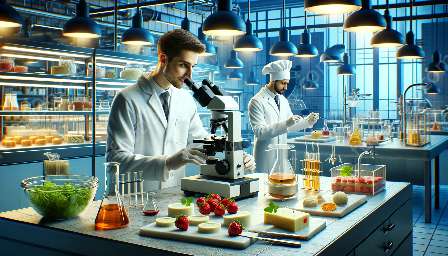Food preservation is a vital aspect of culinary arts and food science that involves using various techniques to prolong the shelf life of food while maintaining its nutritional value and flavor. The field of food preservation is deeply intertwined with food microbiology and culinology, as it requires an understanding of microbiological processes and culinary techniques to ensure safe and effective preservation.
Exploring Food Preservation
Food preservation refers to the process of treating and handling food to stop or slow down spoilage, loss of quality, and deterioration. This practice has been essential throughout human history to ensure a stable food supply, especially during times of scarcity or when produce is not in season. From ancient methods like drying and fermenting to modern technologies such as freezing and canning, food preservation techniques have evolved to cater to a wide range of food products and consumer preferences.
The Role of Food Microbiology
Food microbiology plays a crucial role in food preservation, as it focuses on the study of microorganisms in food and their potential impact on food quality, safety, and spoilage. Understanding the behavior of bacteria, yeast, and molds in various preserved foods is essential for developing effective preservation methods that prevent microbial contamination and spoilage. Moreover, advancements in food microbiology have contributed to the development of novel preservation techniques, such as high-pressure processing and irradiation, which can extend the shelf life of perishable foods while preserving their sensory attributes and nutritional content.
The Intersection of Culinology and Food Preservation
Culinology, a discipline that combines culinary arts and food science, plays a significant role in the development of innovative food preservation methods. Culinologists leverage their understanding of ingredient functionality, flavor profiles, and culinary techniques to create appealing and palatable preserved food products. By incorporating scientific knowledge with culinary artistry, culinologists develop recipes and processing techniques that not only preserve food but also enhance its taste, texture, and visual appeal.
Principles of Food Preservation
Food preservation is guided by several principles that take into account the nature of the food product, the desired shelf life, and the preservation method. Some of the key principles of food preservation include:
- Preventing Microbial Growth: Many preservation techniques aim to create conditions unfavorable for microbial growth, such as reducing water activity, modifying pH levels, or employing thermal processing to destroy microorganisms.
- Minimizing Oxygen Exposure: Oxidation can lead to rancidity and deterioration of food quality. Packaging methods that minimize oxygen exposure, such as vacuum sealing and modified atmosphere packaging, help preserve food products.
- Controlling Temperature: Cold storage, freezing, and refrigeration are effective methods for slowing down enzymatic reactions and microbial growth, thereby extending the shelf life of perishable foods.
- Reducing Water Activity: Drying and dehydration techniques lower the water activity in food, inhibiting the growth of spoilage microorganisms and preserving the food's texture and flavor.
Common Methods of Food Preservation
Various methods of food preservation are employed to cater to different food products and consumer preferences. These methods encompass traditional techniques as well as modern advancements in food science and technology. Some common methods include:
Canning
Canning is a widely used preservation method that involves heating food in airtight containers to destroy microorganisms and enzymes, thereby preventing spoilage. The process often utilizes heat and pressure to create a sterile environment, ensuring the long-term preservation of foods like fruits, vegetables, and meats.
Fermentation
Fermentation harnesses the activity of beneficial microorganisms to preserve foods and enhance their flavor and nutritional value. This method is commonly employed in the preservation of dairy products, vegetables, and beverages like wine and beer.
Freezing
Freezing is a simple yet effective method of preserving food, as it slows down the growth of microorganisms and enzymatic reactions. Frozen foods can retain their quality for an extended period, making freezing a popular preservation choice for a wide range of perishable goods.
Drying
Drying or dehydration involves removing moisture from food products, which inhibits microbial growth and preserves the food's texture and flavor. This method is utilized in the preservation of fruits, herbs, and meats, creating shelf-stable products with a prolonged storage life.
Pickling
Pickling is a preservation technique that involves immersing food in a brine or acidic solution, creating an environment inhospitable to spoilage microorganisms. The acidity of the pickling solution not only preserves the food but also imparts unique flavors and textures to the preserved products.
Advancements in Food Preservation Technology
With the continuous evolution of food science and technology, novel methods of food preservation have emerged, offering enhanced shelf life, improved sensory quality, and increased convenience for consumers. Some notable advancements include:
High-Pressure Processing (HPP)
HPP involves subjecting food products to high levels of hydrostatic pressure, which effectively destroys pathogenic microorganisms and spoilage enzymes while preserving the food's nutritional content and sensory attributes. This non-thermal preservation method has gained popularity for maintaining the freshness and quality of products like juices, meats, and ready-to-eat meals.
Modified Atmosphere Packaging (MAP)
MAP modifies the atmosphere within a packaged food product to extend its shelf life. By controlling the composition of gases surrounding the food, MAP inhibits microbial growth and enzymatic activities, preserving the product's quality and appearance. This method is widely used for fresh produce, meats, and convenience foods.
Irradiation
Irradiation is a preservation technique that utilizes ionizing radiation to reduce microbial load and extend the shelf life of various food products. When applied within recommended doses, irradiation effectively eliminates bacteria, molds, and insects, ensuring the safety and longevity of preserved foods without compromising their nutritional value.
Conclusion
Food preservation is a multifaceted discipline that intertwines the realms of food microbiology and culinology to safeguard the integrity, safety, and sensory properties of food. By leveraging ancient traditions, cutting-edge technology, and scientific expertise, the art of food preservation continues to evolve, offering an extensive array of preserved products that cater to diverse culinary cultures and consumer needs.


